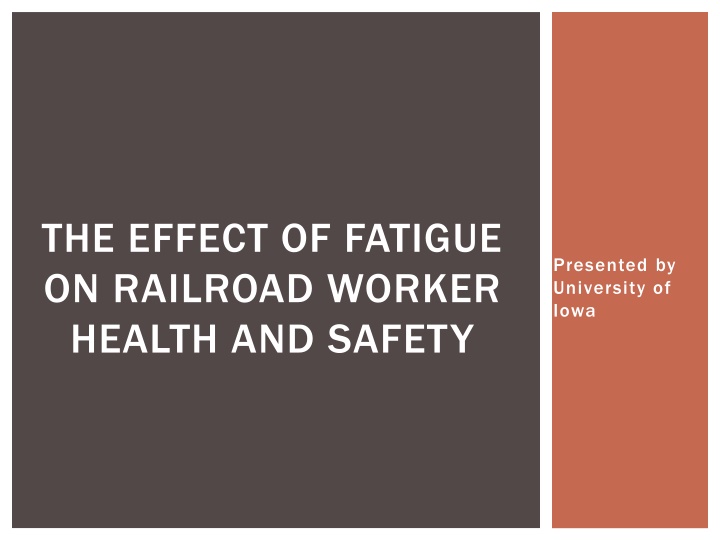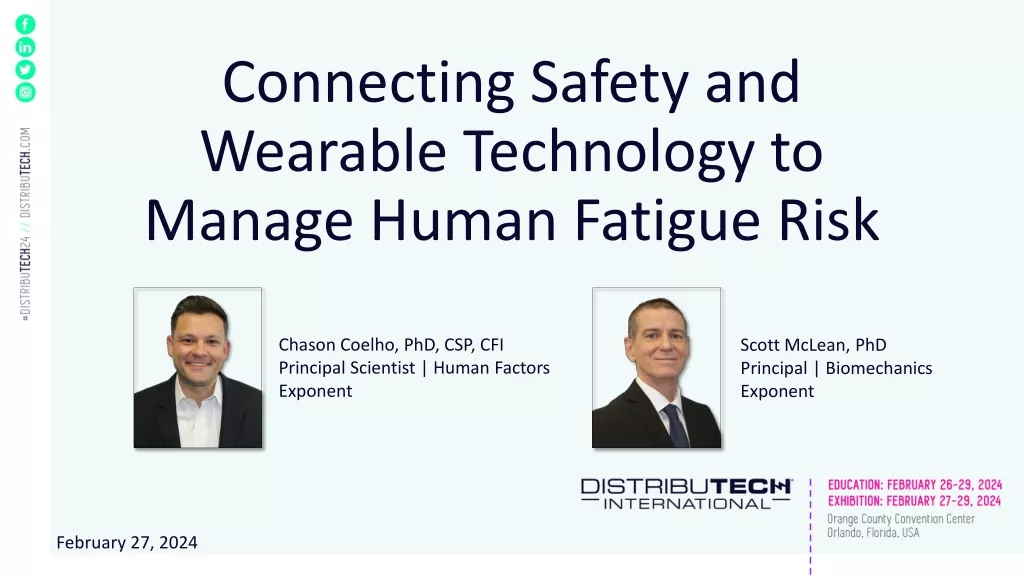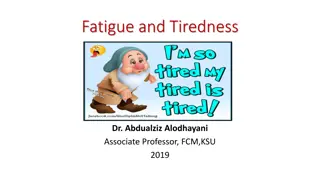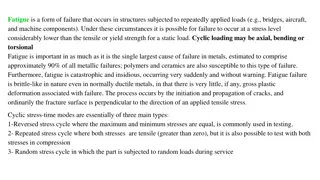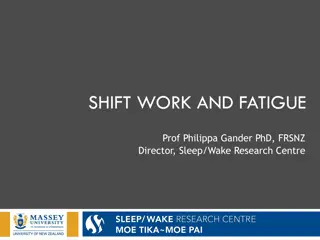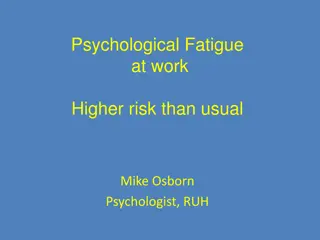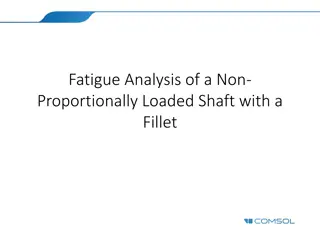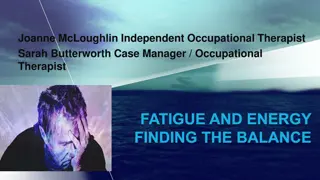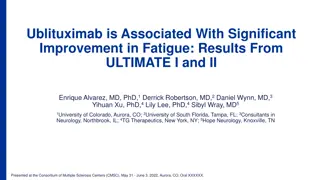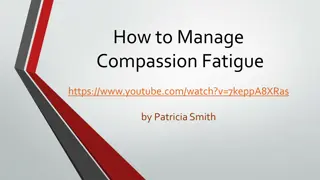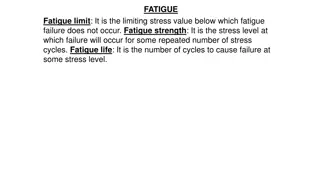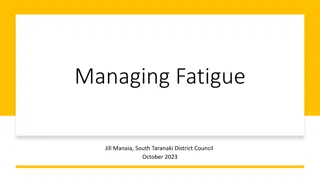Impact of Fatigue on Railroad Worker Health & Safety
The effects of fatigue on railroad worker health and safety are explored in this presentation by the University of Iowa. It delves into the circadian rhythms, peak sleepiness times, body clock influences, and challenges of irregular sleep schedules. Understanding these factors is crucial for optimizing alertness and performance during work hours.
Download Presentation

Please find below an Image/Link to download the presentation.
The content on the website is provided AS IS for your information and personal use only. It may not be sold, licensed, or shared on other websites without obtaining consent from the author.If you encounter any issues during the download, it is possible that the publisher has removed the file from their server.
You are allowed to download the files provided on this website for personal or commercial use, subject to the condition that they are used lawfully. All files are the property of their respective owners.
The content on the website is provided AS IS for your information and personal use only. It may not be sold, licensed, or shared on other websites without obtaining consent from the author.
E N D
Presentation Transcript
THE EFFECT OF FATIGUE ON RAILROAD WORKER HEALTH AND SAFETY Presented by University of Iowa
WHEN DOES YOUR BODY WANT TO SLEEP?
DESIGN SPECS OF THE HUMAN MACHINE Humans were not designed for Humans were not designed for peak performance at night peak performance at night Source: Circadian Technologies, Inc.
THE BODY CLOCK THE BODY CLOCK Known as circadian rhythms Operates on a 24-hour cycle Makes you sleepy when it s dark and awake when it s light Controls a variety of body functions: Sleepiness Digestion Hormone production Body temperature Source: Australia Civil Aviation Safety Authority
CIRCADIAN RHYTHM OF PERFORMANCE OVER A 24 24- -HOUR HOUR PERIOD No Sleep No Sleep Sleep Sleep 98.5 98.5 Maximum Maximum Sleepiness Sleepiness Body Body Core Core Temperature Temperature 96.5 96.5 Thermostat Thermostat Down Down Thermostat Thermostat Up Up Thermostat Thermostat Down Down Thermostat Thermostat Up Up 11 11 pm pm 11 11 pm pm 7 7 am am 7 7 am am Dusk Dusk Dawn Dawn Dusk Dusk Dawn Dawn Whether we are awake or asleep, body Whether we are awake or asleep, body functions continue to follow their Circadian functions continue to follow their Circadian rhythms rhythms Source: Circadian Technologies, Inc.
DAILY SLEEPINESS AND PERFORMANCE DAILY SLEEPINESS AND PERFORMANCE RHYTHMS RHYTHMS Two Times of Peak Sleepiness Each Day About 3 to 5 A.M. About 3 to 5 P.M. 1400 1200 Number of Collisions 1000 800 600 400 200 0 Midnight 6:00 AM Time of Day Source: Certified Occupational Safety Specialist Training
IRREGULAR SLEEP SCHEDULES Difficult to fall asleep when circadian rhythms have you awake. Employees can adjust their sleep habits, but circadian rhythm doesn t change unless you fool body into thinking it is day when its night. Takes at least 3 full days to adjust, longer to day sleep than back to night sleep Less than 24 hour wake/sleep cycle extremely disruptive to ability to sleep.
WHEN SHOULD YOU SLEEP TO BE MOST ALERT FOR YOUR TOUR OF DUTY?
SLEEP SLEEP A Highly Complex Physiological Process During Which the Brain and Body Alternate Between Periods of Extreme Activity and Quiet, but Are Never Shut off. Source: Certified Occupational Safety Specialist Training
WHAT DO WE KNOW? WHAT DO WE KNOW? Sleep Is a Vital Need One-third of Our Life SHOULD BE Spent Asleep The Average Person Needs at Least 8 Hours of Uninterrupted Sleep Some People Mistakenly Feel They Don t Need a Full Night s Sleep. SHOULD BE 10 Source: Certified Occupational Safety Specialist Training
THE TWO STATES OF SLEEP THE TWO STATES OF SLEEP State I State I Non-REM Sleep Physical and Mental Activities Slow Physical Restoration Occurs State II State II REM: Rapid Eye Movement Extreme Mental Activity Mental Restoration Major Muscles Are Paralyzed 11 Source: Certified Occupational Safety Specialist Training
SLEEP CYCLES Stage 1 Transition Can hear and Respond If awakened will believe didn t sleep Stage 2 Light Sleep Slow Brain Waves Easily Awakened but not aware of surroundings Stage 4 REM Sleep Brain Waves Same as When Awake Limb Muscles Paralyzed Mental Restoration 60-90 min. cycle 4-5 Cycles for Complete Sleep Stage 3 Deep Sleep Very Slow Brain Waves Physical Restoration
WHAT HAPPENS IF YOU DON T GET ENOUGH SLEEP?
ACCUMULATING A SLEEP DEBT ACCUMULATING A SLEEP DEBT Sleep Loss Is Cumulative and Builds a Debt People whose sleep was restricted to 4 to 5 hours per night for one week needed two full nights sleep to recover vigilance, performance, and normal mood How Do You Get Out of Sleep Debt? SLEEP!. Source: Certified Occupational Safety Specialist Training
ARE YOU SLEEP DEPRIVED? According to Dr. James Maas, author of Power Sleep, Often we are totally unaware of our own reduced capabilities because we become habituated to low levels of alertness. Many of us have been sleep deprived for such a long time that we don't know what it's like to feel wide awake. Source: United States Mine Rescue Association
ARE YOU SLEEP DEPRIVED? "A study showed that 50% of the people who caused car crashes did not perceive that they were sleepy immediately prior to the crash," says Mark Mahowald, MD, director of the Minnesota Regional Sleep Disorders Center and a spokesman for the National Sleep Foundation. "So if you talk to people who are sleep-deprived, half of the time they will be driving impaired but do not perceive themselves to be." Source: United States Mine Rescue Association
FACTS ABOUT SLEEP DEBT When you are sleepy You tend to over-estimate your own alertness Your judgment isn t as good When you are very sleepy, motivation can t stop you from falling asleep It is harder to cope with fatigue as you get older Source: British Petroleum Fatigue Safety Training
WHAT IS FATIGUE? WHAT IS FATIGUE? Fatigue Is a Complex State Characterized by a Lack of Alertness and Reduced Mental and Physical Performance, Often Accompanied by Drowsiness Misconception: Fatigue Is Not Just Falling Asleep. Not Source: Certified Occupational Safety Specialist Training
MENTAL FATIGUE MENTAL FATIGUE Tired and Drowsy Due to Loss of Sleep Loss of Concentration And/Or Alertness Diminished Levels of Creativity and Logic. 19 Source: Certified Occupational Safety Specialist Training
PHYSICAL FATIGUE PHYSICAL FATIGUE A Decrease in Physical Performance A Feeling of Muscle Discomfort or Soreness Lack of Energy. 20 Source: Certified Occupational Safety Specialist Training
DECISION FATIGUE DECISION FATIGUE Research shows that the human brain has a limit to how many decisions it can make before it starts to shut down When decision fatigue sets in people naturally have less impulse control, make impulsive (often bad) decisions Need to be early in decision fatigue cycle to make tough decision; default to easiest decision when fatigue sets in. Examples: Parole Board Poverty Food Choices Decision Fatigue reset by break with food or sleep.
FATIGUE AFFECTS PERFORMANCE FATIGUE AFFECTS PERFORMANCE LIKE BEING DRUNK LIKE BEING DRUNK 19 Hours Without Sleep Is Similar to a BAC of .05% 24 Hours Without Sleep Is Similar to a BAC of .10%. 0.10% 0.09% 0.08% 0.07% 0.06% 0.05% 0.04% 0.03% 0.02% 0.01% 0.00% 0 HOURS 19 Hours 24 HOURS 22 Source: Certified Occupational Safety Specialist Training
INCIDENTS RELATED TO INCIDENTS RELATED TO CIRCADIAN DISRUPTION CIRCADIAN DISRUPTION Chernobyl Bhopal Three Mile Island Exxon Valdez Most Mistakes by Rail Employees 3-5 am 1:23 am 12:40 am 4:00 am 12:04 am 23 Source: Certified Occupational Safety Specialist Training
EFFECTS OF IRREGULAR 24/7 WORK SCHEDULES ON EMPLOYEE FATIGUE Disrupted sleep at home Chronic sleep deprivation Lack of awareness of extent of sleep debt Micro-sleep Automatic behavior syndrome Source: Circadian Technologies, Inc.
SHIFT-WORK SLEEP DISORDER (SWSD) A sleep disorder that affects people who frequently rotate shifts or work at night. Schedules of these people go against the body s natural Circadian rhythm, and individuals have difficulty adjusting to the different sleep and wake schedule. SWSD consists of a constant or recurrent pattern of sleep interruption that results in insomnia or excessive sleepiness. This disorder is common in people who work non- traditional hours usually between the hours of 10:00 p.m. and 6:00 a.m. Source: United States Mine Rescue Association
MICROSLEEP MICROSLEEP Short bursts of sleep waves Seconds or minutes long Eyelid blinking slows down Often precedes nodding off Loss of awareness Fatigue/monotony induced Serious driving and work hazard Source: Circadian Technologies, Inc.
AUTOMATIC BEHAVIOR AUTOMATIC BEHAVIOR SYNDROME SYNDROME Sleeping with eyes open Blank stare, no eye blinking Deep sleep (brain) waves Loss of perception and memory Fatigue/monotony induced Inability to respond to changes Major cause of driving accidents Source: Circadian Technologies, Inc.
FATIGUE RELATED DRIVING FATIGUE RELATED DRIVING ACCIDENTS ACCIDENTS 6 times greater for night shift workers 2 times greater for rotating shift workers Other high risk factors Getting less than 6 hours sleep Being awake more than 20 hours straight Driving between midnight and 6:00 am Sources: AAA Study, J. Stutts, UNC 1999
COMMUTING COMMUTING One of the most dangerous things you can do while fatigued is drive You may be driving during the very times that your body most wants to sleep Nightshift workers are 4 to 7 times as likely to have an accident driving home. Source: Australia Civil Aviation Safety Authority
HEALTH EFFECTS OF EXTENDED AND IRREGULAR SLEEP HOURS 3-4 times higher rate of Obstructive Sleep Apnea 2-3 times greater rate of Gastrointestinal Disorders 2-3 times increased rate of Cardiovascular Disease 1.5-2 times more Musculoskeletal Problems Source: Circadian Technologies, Inc. 18 18
BIOLOGICAL AND SOCIAL EFFECTS BIOLOGICAL AND SOCIAL EFFECTS ON IRREGULAR AND EXTENDED HOURS IRREGULAR AND EXTENDED HOURS ON 60 to 80% Have Chronic Sleep Problems 80% Affected by Chronic Fatigue 5 to 15 Times More Likely to Suffer From Mood Swings and Depression Divorce and Spousal Abuse Rates Higher Drug and Alcohol Abuse Rates Higher. 31 Source: Certified Occupational Safety Specialist Training
KEY POINTS Fatigue has biological causes Fatigue has biological causes The effects of sleep loss build up The effects of sleep loss build up If you ignore sleepiness, in the end you will fall asleep If you ignore sleepiness, in the end you will fall asleep uncontrollably; no amount of motivation will stop that uncontrollably; no amount of motivation will stop that Two full consecutive nights of good sleep are needed Two full consecutive nights of good sleep are needed for full recovery for full recovery The body clock programs us to sleep at night The body clock programs us to sleep at night The clock does not adapt to night work The clock does not adapt to night work There is no single, simple answer to fatigue problems There is no single, simple answer to fatigue problems Source: British Petroleum Fatigue Safety Training
